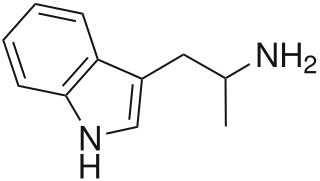
α-Methyltryptamine is a psychedelic, stimulant, and entactogen drug of the tryptamine class. It was originally developed as an antidepressant by workers at Upjohn in the 1960s, and was used briefly as an antidepressant in Russia under the trade name Indopan before being discontinued.

2C-T-7 is a psychedelic phenethylamine of the 2C family. In his book PiHKAL: A Chemical Love Story, Alexander Shulgin lists the dosage range as 10–30 mg. 2C-T-7 is generally taken orally, and produces psychedelic and entactogenic effects that last 8 to 15 hours. Up until Operation Web Tryp and three deaths, two of which involved the use of other drugs in addition to 2C-T-7, and one which involved an excessive insufflated dose, 2C-T-7 was sold commercially in Dutch and Japanese smartshops and online. It is known on the streets as Blue Mystic or 7th Heaven. There has been little real research done on this chemical other than Shulgin's comments in PiHKAL and a few small animal studies mostly aimed at detecting metabolites.
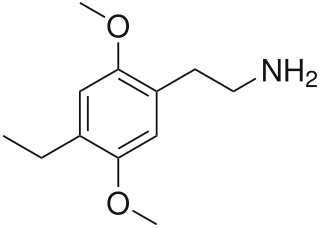
2C-E is a psychedelic phenethylamine of the 2C family. It was first synthesized by Alexander Shulgin and documented in his book PiHKAL. Like the other substances in its family, it produces sensory and cognitive effects in its physical reactions with living organisms.

2C-T-2 is a psychedelic and entactogenic phenethylamine of the 2C family. It was first synthesized in 1981 by Alexander Shulgin, and rated by him as one of the "magical half-dozen" most important psychedelic phenethylamine compounds. The drug has structural and pharmacodynamic properties similar to those of 2C-T-7.

5-MeO-DMT (5-methoxy-N,N-dimethyltryptamine) or O-methyl-bufotenin is a psychedelic of the tryptamine class. It is found in a wide variety of plant species, and also is secreted by the glands of at least one toad species, the Colorado River toad. Like its close relatives DMT and bufotenin (5-HO-DMT), it has been used as an entheogen in South America. Slang terms include Five-methoxy, the power, bufo, and toad venom.

2C-C is a psychedelic drug of the 2C family. It was first synthesized by Alexander Shulgin, sometimes used as an entheogen. In his book PiHKAL , Shulgin lists the dosage range as 20–40 mg. 2C-C is usually taken orally, but may also be insufflated. 2C-C is schedule I of section 202(c) of the Controlled Substances Act in the United States, signed into law as of July, 2012 under the Food and Drug Administration Safety and Innovation Act.

2C-D is a psychedelic drug of the 2C family that is sometimes used as an entheogen. It was first synthesized in 1970 by a team from the Texas Research Institute of Mental Sciences, and its activity was subsequently investigated in humans by Alexander Shulgin. In his book PiHKAL, Shulgin lists the dosage range as being from 20 to 60 mg. Lower doses of 10 mg or less have been explored for microdosing.
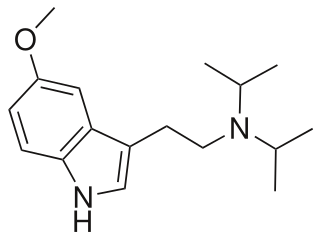
5-Methoxy-N,N-diisopropyltryptamine is a psychedelic tryptamine and the methoxy derivative of diisopropyltryptamine (DiPT).

5-MeO-aMT or 5-methoxy-α-methyltryptamine, α,O-Dimethylserotonin (Alpha-O) is a potent psychedelic tryptamine. It is soluble in ethanol.

4-Hydroxy-N,N-diisopropyltryptamine is a synthetic psychedelic drug. It is a higher homologue of psilocin, 4-HO-DET, and is a positional isomer of 4-HO-DPT and has a tryptamine molecular sub-structure.

4-HO-DET, also known as 4-hydroxy-diethyl-tryptamine, CZ-74, is a hallucinogenic drug and psychedelic compound of moderate duration. 4-HO-DET is a substituted tryptamine, structurally related to psilocin, ethocybin, and 4-HO-DIPT.

4-Acetoxy-DET (4-Acetoxy-N,N-diethyltryptamine), also known as ethacetin, ethylacybin or 4-AcO-DET, is a psychedelic tryptamine. It was first synthesized in 1958 by Albert Hofmann in the Sandoz lab.
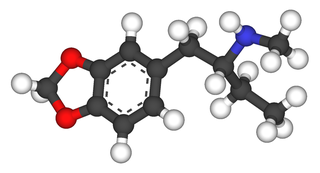
1,3-Benzodioxolyl-N-methylbutanamine (N-methyl-1,3-benzodioxolylbutanamine, MBDB, 3,4-methylenedioxy-N-methyl-α-ethylphenylethylamine) is an entactogen of the phenethylamine chemical class. It is known by the street names Eden and Methyl-J. MBDB is a ring substituted amphetamine and an analogue of MDMA. Like MDMA, it has a methylene dioxy substitution at the 3 and 4 position on the aromatic ring; this is perhaps the most distinctive feature that structurally define analogues of MDMA, in addition to their unique effects, and as a class they are often referred to as "entactogens" to differentiate between typical psychostimulant amphetamines that (as a general rule) are not ring substituted. MBDB differs from MDMA by having an ethyl group instead of a methyl group attached to the alpha carbon; all other parts are identical. Modification at the alpha carbon is uncommon for substituted amphetamines. It has IC50 values of 784 nM against 5-HT, 7825 nM against dopamine, and 1233 nM against norepinephrine. Its metabolism has been described in scientific literature.

4-Acetoxy-DiPT is a synthetic psychedelic tryptamine. It is relatively uncommon and has only a short history of human use.

4-HO-MiPT is a synthetic substituted aromatic compound and a lesser-known psychedelic tryptamine. It is thought to be a serotonergic psychedelic, similar to magic mushrooms, LSD and mescaline. Its molecular structure and pharmacological effects somewhat resemble those of the tryptamine psilocin, which is the primary psychoactive chemical in magic mushrooms.

2,5-Dimethoxy-4-chloroamphetamine (DOC) is a psychedelic drug of the phenethylamine and amphetamine chemical classes. It was presumably first synthesized by Alexander Shulgin, and was described in his book PiHKAL.
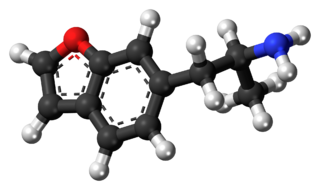
6-APB is an empathogenic psychoactive compound of the substituted benzofuran and substituted phenethylamine classes. 6-APB and other compounds are sometimes informally called "Benzofury" in newspaper reports. It is similar in structure to MDA, but differs in that the 3,4-methylenedioxyphenyl ring system has been replaced with a benzofuran ring. 6-APB is also the unsaturated benzofuran derivative of 6-APDB. It may appear as a tan grainy powder. While the drug never became particularly popular, it briefly entered the rave and underground clubbing scene in the UK before its sale and import were banned. It falls under the category of research chemicals, sometimes called "legal highs." Because 6-APB and other substituted benzofurans have not been explicitly outlawed in some countries, they are often technically legal, contributing to their popularity.

1P-LSD is a psychedelic drug of the lysergamide class that is a derivative and functional analogue of LSD and a homologue of ALD-52. It originated in 2015 when it appeared a designer drug sold online. It modifies the LSD molecule by adding a propionyl group to the nitrogen molecule of LSD's indole group.
The legal status of drugs and drug precursors varies substantially from country to country and is still changing in many of them. United Nations classify drugs internationally, it affects all its member states.

1cP-LSD is an acylated derivative of lysergic acid diethylamide (LSD), which has been sold as a designer drug. In tests on mice it was found to be an active psychedelic with similar potency to 1P-LSD.




















